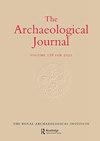The English folly: the edifice complex
IF 0.8
0 ARCHAEOLOGY
引用次数: 0
Abstract
rather than imperial – is likely to mark the establishment of the civitas Brigantum. The site was to prove of enduring importance to the supply of the frontier, and possibly to the administration of the annona in the later third and fourth centuries, particularly evidenced through large warehouses in the north-east corner of the town, and – perhaps – a large building in the north annexe, one of two such unusual and newly discovered late Roman additions to the town’s defences. The reader is informed that further fieldwork to locate the wharves necessary for landing supplies is planned, and these results will be eagerly awaited. The implications of the model of development suggested could perhaps be taken further. If London provides a model, the importance of Gallic peoples and other communities of the imperial mercantile diaspora should be considered at Aldborough as it has been for London. The apparent preference for urban living of elites at Aldborough from the beginning of the settlement, and the reduced emphasis on agricultural wealth seen by Ferraby and Millett, may be linked to the demography and identities of those creating the settlement. We might thus envisage a more diverse community at Aldborough than is implied in this volume. Perhaps the shifting of the label of the Brigantes from the kingdom and community of Cartimandua to the new civitas at Aldborough represents a transfer of power between people, as well as places? Overall this is a thorough synthesis of a very significant site for understanding Roman Britain as a whole, and the north in particular, and Rose Ferraby, Martin Millett and all those involved in the project are to be congratulated on its publication. The importance of the results, the clarity of thought and expression, and quality of production should garner this volume a wide readership across specialists and non-specialists alike.英国人的愚蠢之处:大厦建筑群
而不是帝国——很可能标志着Brigantum的建立。这个地点被证明对边境的供应具有持久的重要性,可能在第三和第四世纪后期对annona的管理,特别是通过城镇东北角的大型仓库,以及-也许-北附楼的大型建筑,这是罗马晚期新发现的两个不同寻常的城镇防御工事之一。读者被告知,计划进行进一步的实地考察,以确定补给登陆所需的码头,这些结果将被热切地等待。所提出的发展模式的影响也许可以进一步扩大。如果伦敦提供了一个模式,那么高卢人和其他帝国商业侨民社区的重要性应该在奥尔德伯勒得到考虑,就像它对伦敦一样。从定居之初,奥尔德伯勒的精英们就明显倾向于城市生活,而费拉比和米勒特看到的对农业财富的重视程度有所降低,这可能与定居者的人口结构和身份认同有关。因此,我们可能会设想一个更加多样化的社区在奥尔德伯勒比暗示在这一卷。也许布里甘特人的标签从卡蒂曼杜的王国和社区转移到奥尔德伯勒的新公民身上,代表了人与人之间以及地方之间的权力转移?总的来说,这是对一个非常重要的地点的全面综合,对于了解罗马不列颠的整体,特别是北部,罗斯·费拉比,马丁·米勒特和所有参与该项目的人都要祝贺它的出版。结果的重要性,思想和表达的清晰度,以及生产质量应该在专家和非专业人士之间获得广泛的读者群。
本文章由计算机程序翻译,如有差异,请以英文原文为准。
求助全文
约1分钟内获得全文
求助全文

 求助内容:
求助内容: 应助结果提醒方式:
应助结果提醒方式:


